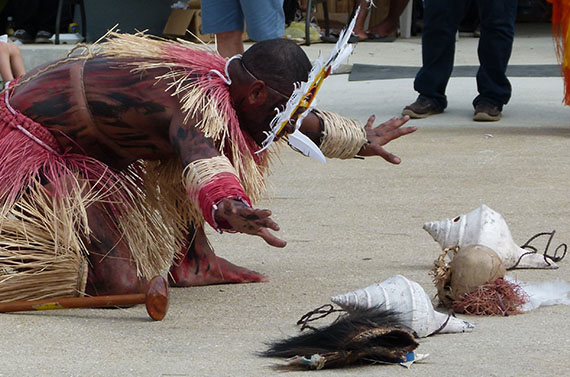The Festival of Pacific Arts and Culture (FOPAC) takes place every four years. Delegates from the islands peppering this vast ocean congregate to share culture, build alliances and discuss issues facing both their independent nations and the region as a whole. In 2016, the festival was hosted by the Chamorro peoples.



The Chamorro are the indigenous peoples of the Mariana Islands group and, a little like the Samoans, their people are divided between being an independent nation — the Northern Mariana Islands — and a United States territory: Guam.
There is a long military history in this part of the Pacific and a continuing presence of US forces. Officers in uniform controlled traffic, directing vehicles around the festival village. They also policed the accommodation in which delegates from various nations were staying. The overwhelming warmth and hospitality of the Chamorro, however, completely softened this presence, inspiring a sense of shared joy in the coming together of such a wonderfully diverse yet connected group of artists.
With delegations from 27 countries and each ranging from 60 to 160 people, hosting the festival is a major logistical exercise. There were multiple sites for different activities, with the main festival village directly opposite the newly constructed and impressive Museum of Guam. Here, multiple straw-roofed pavilions housed artists who were conducting workshops and selling paintings, sculptures, adornments and textiles to appreciative locals and international festival goers. Highlights in this space were the Solomon Islands pavilion with its opulent displays of the shell ornaments known as ‘women’s wealth’, Taiwan’s demonstrations of indigenous weaving, the reconstruction of a traditional house in the Yap pavilion, and the intricately patterned weavings created by the elegant women of Marshall and Ponphei islands. Discussions with academic Greg Dvorak and poet Kathy Jetnil Kijiner revealed a revival of women’s weaving on these islands in recent times as a form of resistance to cultural imperialism, as well as to histories of exploitation and environmental destruction. Kathy led a young group of poets in spoken word, using this contemporary form of expression to actively develop networks of communication in the region. One had the sense that the model of the Yap house was equally a form of local resistance.
Performances occurred throughout the day on various stages and featured some of the regions most celebrated musicians and performance groups, including the Solomon Islands’ Rosie Delmah, New Caledonia’s Resurrection, New Zealand’s Horomona Horo, Maisey Rika and Rob Ruha, and Australia’s own Mau Power (Patrick Mau). Moving across to the festival bar after dark, they helped raised the energy levels and had many dancing into the night. Situated on a headland that overlooks a strip of expensive hotels, which are interspersed with designer shops, the Chamorro cultural village gave greater insight into local culture. Small displays of historical and contemporary works were beautifully curated in the old hospital buildings by a group of local volunteers. In addition to hosting performances, the village was where you could experience traditional cooking demonstrations and tastings, or engage with a presentation on indigenous medicine and healing practices as well as tattooing.
Brisbane-based Rako Pacifika wowed audiences with their powerful performances, staged in one of the most beautiful buildings in Guam’s capital, Hagåtña, at sunset. It was also wonderful to also see strong new work by New Zealand artists Lisa Reihana, John Ione, Chris Charteris and Maureen Lander alongside contemporaries from the region, including Cook Islands’ tivaevae artist Tungane Broadbent, who worked with the Gallery in 2005. Lots of colleagues from museums in Britain, Taiwan and the United States were busily acquiring work for collections, progressing research and meeting artists, which made for some rich late-night conversations. A daily visit to the artists’ air-conditioned green room at the museum to check on the latest changes in the schedule often led to impromptu meetings that were equally inspiring. Four very full days and much to follow as QAGOMA’s Asian and Pacific Art team starts to map out The Nineth Asia Pacific Triennial of Contemporary Art (APT9).
This is an extract from the Gallery’s Artlines magazine available from the Gallery Store. Keep up to date with the Gallery’s seasonal publication delivered each quarter to QAGOMA Members.

